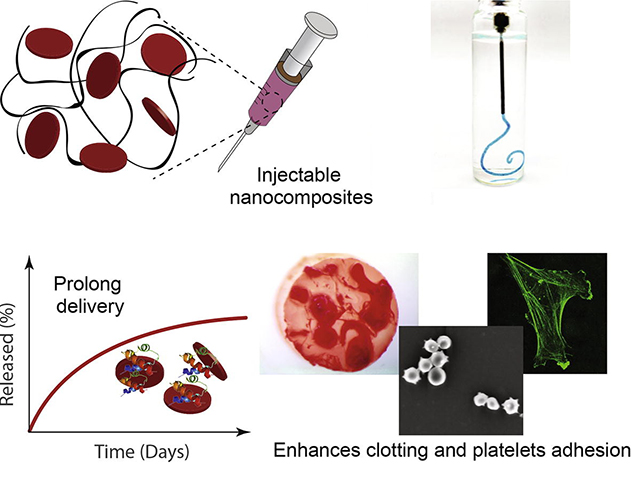You are what you eat, might have just taken on a new meaning as investigators from the Inspired Nanomaterials and Tissue Engineering Laboratory at Texas A&M University have successfully fabricated an injectable bandage to stop bleeding and promote wound healing manufactured using a gelling agent commonly used in preparing pastries and other foods. The new findings were published recently in Acta Biomaterialia, in an article entitled “Nanoengineered Injectable Hydrogels for Wound Healing Application.”
The applications for this type of product are widespread, but military use tops the list, as a penetrating injury from shrapnel is a serious obstacle in overcoming battlefield wounds that can ultimately lead to death. Given the high mortality rates due to hemorrhaging, there is an unmet need to quickly self-administer materials that prevent fatality due to excessive blood loss.
“Injectable hydrogels are promising materials for achieving hemostasis in case of internal injuries and bleeding, as these biomaterials can be introduced into a wound site using minimally invasive approaches,” explained senior study investigator Akhilesh Gaharwar, Ph.D., assistant professor in the department of biomedical engineering at Texas A&M University. “An ideal injectable bandage should solidify after injection in the wound area and promote a natural clotting cascade. In addition, the injectable bandage should initiate wound healing response after achieving hemostasis.”
In the current study, the research team used a common thickening agent known as kappa-carrageenan (κ-carrageenan, or κCA), obtained from seaweed, to design injectable hydrogels. Hydrogels are a 3D water-swollen polymer network, similar to Jell-O, simulating the structure of human tissues.
“We report injectable nanoengineered hemostats for enhanced wound healing and tissue regeneration,” the authors wrote. “The nanoengineered system consists of the natural polysaccharide, κ-carrageenan (κCA), loaded with synthetic two-dimensional (2D) nanosilicates. Nanoengineered hydrogels showed shear-thinning characteristics and can be injected for minimally invasive approaches. The injectable gels can be physically crosslinked in [the] presence of monovalent ions to form mechanically strong hydrogels. By controlling the ratio between κCA and nanosilicates, compressive stiffness of crosslinked hydrogels can be modulated between 20 and 200 kPa.”
When κCA is mixed with clay-based nanoparticles, an injectable gelatin is obtained. The charged characteristics of clay-based nanoparticles provide hemostatic ability to the hydrogels. Specifically, plasma protein and platelets form blood adsorption on the gel surface and trigger a blood clotting cascade.
“Despite high mechanical stiffness, nanocomposite hydrogels are highly porous with an interconnected network,” the authors noted. “The addition of nanosilicates to κCA increases protein adsorption on nanocomposite hydrogels that results in enhance[d] cell adhesion and spreading, increase[d] platelets binding and reduce[d] blood clotting time.”
“Interestingly, we also found that these injectable bandages can show a prolonged release of therapeutics that can be used to heal the wound,” remarked lead study investigator Giriraj Lokhande, a graduate student in Dr. Gaharwar's laboratory. “The negative surface charge of nanoparticles enabled electrostatic interactions with therapeutics, thus resulting in the slow release of therapeutics.”
These multifunctional nanocomposite hydrogels open the door to the possibility of being used as an injectable hemostat for penetrating injury and percutaneous intervention during surgery. While the investigators were encouraged by the results from this study, they note that more testing is required before the hydrogel is put into real-world clinical scenarios.



